News for Summer 2013
A Future For Newstead Abbey by Ceril Little
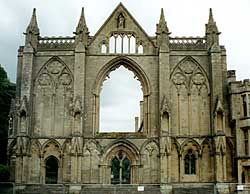
As you may already be aware, Newstead abbey featured on The World Monuments Fund Britain’s Watch List in 2012 due to concerns about its reduced visitor access and deterioration in the fabric of the building. WMF Britain were pleased to note that Nottingham City Council (current owners of the site) had taken steps to address these issues and there was an increase in visitor numbers in 2012.
WMF Britain, committed to helping Newstead to continue addressing the site’s needs, arranged a seminar at Newstead on Saturday, 16 March 2013 to discuss the possibility of setting up a Friends of Newstead group.
The afternoon of the seminar began with a brief talk by City Councillor Trimble, who is in in charge of Leisure, Tourism and Museums. He explained the current financial situation at the City Council. This was followed by two further talks: first by Elaine Griffiths who headed the very successful restoration project at Gorton Monastery, Manchester which was featured in the TV series Restoration a few years ago. The second talk, by Carole Patey, concerned the complete restoration of Horace Walpole’s Strawberry Hill, Twickenham. Both spoke of the need for local support for such projects: in these cases from very different communities. Gorton is a rundown semi-derelict district of Manchester whilst Twickenham is an affluent outer London suburb. How do you see Newstead’s ‘community’?
We then broke up into groups for discussion. In the feedback session, a variety of issues were raised such as the value of volunteers in helping maintain historic sites (little understood by the City Council); the role of the Byron Society, both local and international, in the restoration of Newstead; fund-raising activities such as pop concerts, and the provision of up-to-date camping and caravanning facilities in the surrounding parkland, etc.
A little about the World Monuments fund: it was founded in New York with considerable input from the Paul Mellon Foundation to provide advocacy for historical sites, education about such sites, the training in their management, preservation of the world’s cultural legacy, and in the worst instance, disaster recovery, e.g. from floods. Its policy is to promote a culture of care and to involve local communities.
The seminar ended with all present being asked to state how much time they could commit to Newstead in forming a Friends group. We need a local person to lead in this. Any ideas?
Lenton Priory Update by Gareth Davies (Trent & Peak Archaeology - TPA)
Lenton Priory, founded 1106-7, and abandoned by the monks in 1538, was one of the greatest monastic houses in England. The priory was founded in 1106 or 1107 by the Cluniac order, and became one of the wealthiest houses of an order noted for the size and magnificence of its churches.
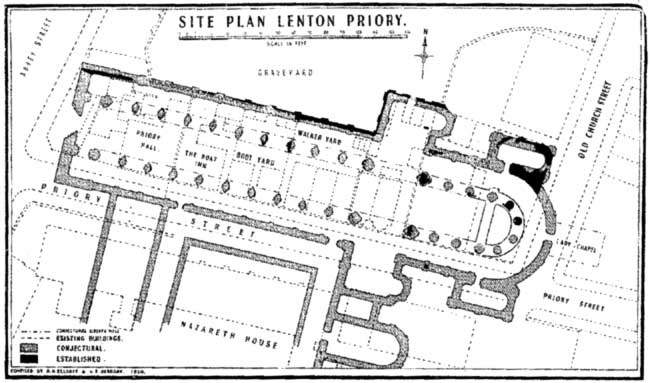
Proposed plan of the Priory Conventual Church from Elliot and Berbank, 1952.
Today, the Chapel of St Anthony and a small portion of a column from the main priory Church is at the junction of Priory Street and Old Church Street are the only standing building elements. Despite small excavations in the earlier Twentieth century and interest from the Lenton Historical Society, the site – a Scheduled Monument of undoubted national importance - is a very underplayed heritage asset with no interpretation or presentation of the site on the ground resulting in a lack of even local awareness of the site.
However, in 2012-2013 major excavations in advance of Nottingham’s new tram link have revealed a huge amount of new information about Lenton Priory and its grounds. So, although the precise location of many of the buildings at Lenton Priory remains unknown, a number of structures, particularly those to the north of the cloister, are now known to survive as significant buried remains. The results of the recent work are now summarised:
Recent results
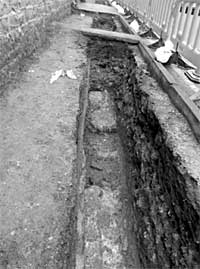
Cable Trench (1m wide) Looking west along the e-w aligned south wall of the northern cloister range, entrance way in mid ground.
TPA have had the opportunity to look at Lenton Priory itself as an electricity cable was realigned. In Old Church St we identified walls relating to the eastern end of the main conventual church. Work extending into Priory St, which broadly follows the West of Abbey Street, excavations within the projected Outer Precinct of the Priory have recovered part of a medieval market within the outer precinct of the Priory. A number of finds including pottery, animal bones and both English and French coins and tokens have started shed important light on the workings of this important Church administered trading site.
The latest features on this site comprise Fourteenth to Sixteenth century rubbish pits, a stone built cess pit and possible timber framed stalls. Prior to this activity, Fourteenth and Thirteenth century ditches following the line of Abbey Street have been identified. There are also tenement-type plot boundaries and post-built stall structures. A number of coins dating to the reign of Edward III suggest a particular floruit of economic activity at this time.
Lenton Priory is a much underplayed heritage asset of national significance and, especially given the new discoveries, any opportunity for its promotion, exploration and presentation should be explored. To this end, Trent & Peak Archaeology are exploring the possibility, in conjunction with the alignment of the Lenton Priory Church, recovered the entire south wall of the northern cloister range (including architectural details and entrance ways) and the total width of the South transept was also identified. These astounding results will eventually allow much of the ground plan of Lenton Priory to be reconstructed with confidence for the first time. Further trenches in old Church St. also recovered small amounts of human remains representing medieval burials.
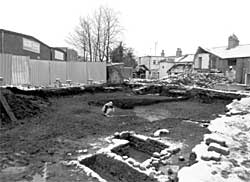
The profile through the large Eleventh to Twelfth century ditch sequence with the Fourteenth to Sixteenth century stone-built cess pit in the foreground. Looking north.
However, perhaps most interestingly, the earliest activity on site is represented by a very large ditch sequence - perhaps a defended routeway - that does not follow the line of Abbey Street. The pottery from these ditches suggests, at latest, an infilling date in the mid Twelfth century. On present evidence it seems that these features belong to the very earliest phases of activity associated with the Cluniac priory which was initially built in 1106-7. Important finds from these ditches include fragments of medieval leather shoes. If these ditches were actually dug as early as the Eleventh century, then they could relate to an important but previously unknown Anglo-Saxon site. At the time of Domesday Book (1086), Lenton is recorded as 'waste' but was land previously owned by the King; might Lenton have been the site of a previously unknown Late Anglo-Saxon royal manor? City Council and the Lenton Historical Society, of undertaking a geophysical survey in the remaining green areas around the priory complex to coincide with the Festival of British Archaeology this summer.
D. H. Lawrence and Women
A recent article noted on the BBC local web site throws new light on Lawrence’s attitude to women. This information has arisen following the discovery of an unpublished article by Lawrence by Dr. Andrew Harrison of the University of Nottingham. who had been asked to study a collection of papers acquired by a library in New Zealand.
Dr. Harrison is quoted as saying: A new find like this is pretty rare. It reveals Lawrence’s enlightened attitude to gender issues, and his acuteness in detecting and exposing sexist attitudes. The article was responding to an article in The Adelphi monthly journal edited by John Middleton Murray, the husband of New Zealand author Katherine Mansfield. The article by a man identified only as JHR was entitled The Ugliness of Womenin which the author writes about the horrified reaction he felt towards beautiful women. He wrote: In every woman born there is a seed of terrible, unmentionable evil: evil such as man – a simple creature for all his passions andlusts – could never dream of in the most horrible of nightmares, could never conceive in imagination.
In his article Lawrence said: The hideousness he [JHR] sees is the reflection of himself, and of the automatic meat-lust with which he approaches another individual ... Even the most ‘beautiful’ woman is still a human creature. If he approached her as such, as a being instead of as a piece of lurid meat, he would have no horrors afterwards.
Dr. Harrison is reported as thinking that the item was written during Lawrence’s return to Europe from Mexico between 12 December 1923 and 5 March 1924 and that Murray may not have published it because it was thought to be libelous or too outspoken – attitudes which, of course, are not held today.
Sir James/Jacob Cats by John Wilson
Recently the Society received a query from Professor Johan Koppenol, Professor of Older Dutch Literature at the VU University, Amsterdam. Professor Koppenol is researching the life of Jacob Cats (1577-1660), who is well known in the Netherlands as a writer and poet, and in England was known as Sir James Cats, the Dutch statesman.
Cats came to England in the 1620s and was involved, as an investor, in the Hatfield Chase drainage project. This massive project was undertaken by Sir Cornelius Vermuyden and covered an area of north Nottinghamshire, South Yorkshire and North Lincolnshire.
Professor Koppenol is of the opinion that Cats at one time purchased the Manor of Finningley (now in South Yorkshire but prior to 1974 in Nottinghamshire).
This is also stated in Bramley (Sir Cornelius Vermuyden, J. Bramley, Transactions of the Thoroton Society, 35 (1931), 109-116) who considers that in 1628, Vermuyden purchased from King Charles I 2,600 acres of land in Misson and Finningley. Running short of funds, Vermuyden sold half his land to Cats, who acquired the Manor of Finningley. However, a history of Finningley(www.finningley.org/detail_history.htm, 15 April 2013) indicates that Finningley Grange was granted to Sir Martin Frobisher in 1576. The Frobishers held the property until the late 17th century when the Harvey family of Ickwell, Bedfordshire, took over.
So, we have a difference of opinion. Professor Koppenol would be interested in learning if any member of the Society has any knowledge of Sir James Cats’ time in England which we could pass on to him.
The Nottinghamshire Bibliography Online Project by Andy Nicholson
The first comprehensive bibliography of Nottinghamshire history was compiled by Michael Brook and published by the Thoroton Society in 2002. Brook’s bibliography is a major achievement and includes 8707 items relating to "books (and discrete portions of books), pamphlets, periodical articles, and academic theses at doctoral and master’s levels" published before 1998. A PDF version of the publication can be downloaded from the Thoroton Society website: it can be searched at very basic level but cannot be updated.
In December 2011 the Thoroton Society and Nottingham University's Department of Manuscripts and Special Collections embarked on a project to update Brook's bibliography and make it available on the Internet. An online database has been developed and the whole of Brook's bibliography has been converted and uploaded to the database. A further 2,300 bibliographical records, covering 1997 to the present, have also been added. The project has also widened the scope of the original bibliography to include a wide range of 'grey literature' (material that has not been formally published) and, wherever possible, provide a link to online versions of publications.
It is hoped that the online bibliography will become a significant aid to anyone researching Nottinghamshire history and will be officially launched later this year.
Anniversaries by Ken Brand
It is annoying missing anniversaries, particularly if it is a 150th anniversary. On the 11th November 1862 the Nottingham Architectural Society was instituted. The Society’s first president 1862-63 was Henry Moses Wood, architect and a former Borough Surveyor and Engineer. His Vice-President and successor was Thomas Chambers Hine who held the post for ten years, 1863-73.
There were 22 founder members, 21 paying a subscription of a guinea that gave an initial income of £22-1-0d. These members included the older architects who created the appearance of mid and late Victorian Nottingham. Besides Wood and Hine, the cast list includes Bakewell, Booker (x3), Clarke, Evans, Gilbert, Frederick Jackson (secretary), Jalland (treasurer), Sutton, Tarbotton and Walker. In time younger, more familiar architects joined the Society.
Their first outing took place in August 1863, 17 members travelled first class to Lichfield, paying 6/9d each return for the journey. The treasurer’s account notes ‘To paid vergers at Cathedral 10 shillings.’
The Nottingham Architectural Society remained independent until March 1913 when it amalgamated with the Derby Society, instituted 13th March 1908. T. C. Hine was born on 31st May 1813, thus the bicentenary of his birth is occurs this year. The Nottingham Civic Society has commissioned a memorial stone to celebrate this occasion.
The Late Vernon Radcliffe
An obituary for the late Vernon Radcliffe, former Vice-President of the Thoroton Society, appeared in the Autumn 2011 Newsletter. JOHN WILSON believes members will be interested in additional information.
Vernon was a member of the Royal Meteorological Society for many years, and a committee member of their History of Meteorology and Oceanography group. His interest in the weather began as a schoolboy in Rotherham. He befriended Mr. Leslie Atkinson, an industrial chemist in the mining industry, who was an amateur weather observer. Vernon took the daily readings at Mr. Atkinson’s weather station when the latter was away on holiday. Vernon corresponded with Dr. John Glasspoole, at one time the President of the Royal Meteorological Society and a leading light in the then British Rainfall Association. Dr. Glasspoole encouraged Vernon to visit a number of amateur weather recorders to see their weather stations.
One such that he visited was that at 62, Camden Square in London, which was once the home of Dr. G. J. Symons, the founder of the British Rainfall Organisation. Vernon stated:
Unfortunately I was to give Dr. Glasspoole a poor report on the state of the 5” gauge (the rain gauge] and he transmitted it to Mr. E. L. Hawke, secretary of the Royal Meteorological Society, who was then responsible[for the site] , and he wrote to my Headmaster in no uncertain terms saying that I was meddling in matters which did not concern me! Mr. Field, the Head, did not like it! (Letter from Vernon Radcliffe to Mr. R. W. Rattray of the Meteorological Office 1997).
Industry in the Rotherham area maintained a heavy smoke pall over the city, and this aroused Vernon’s interest in air pollution. Vernon contacted Mr. James Law, the Chief Smoke Inspector for Rotherham, who gave Vernon some porcelain cylinders coated with lead peroxide with which to measure air pollution. Vernon also made a particle deposit gauge to examine the dust in the atmosphere of Rotherham.
Vernon reported daily rainfall observations from Rotherham to the British Rainfall Organisation for the period 1939 to 1954, then from Walthamstow Museum from 1956 to 1960. From 1960 to 1965 he worked as an observer at the official weather station at Kew and then moved to Balderton in 1965 from where he continued to report rainfall. In 1988 he was awarded a book by the Meteorological Office for his services as a rainfall observer, and in 1995 he received a crystal bowl in recognition of his 56 years’ service as an observer. (Met. Office official station record for the Balderton Rainfall Recording Station.). His M.B.E. followed in 1997.
I am grateful to Mark Beswick of the National Meteorological Library and Archives for the above information.
ALFRED S. BOWLEY
9 February 1920 – 8 February 2013
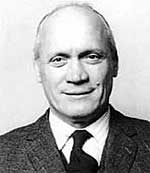
Alf, as he was known to his many friends, died just one day before his 93rd birthday, after a long illness. He was born and brought up in Basford and late in life wrote the first history of that suburb. He left the Ellis School at the age of 14 and went to work in the offices of Smith Brothers & Co Ltd., valve manufacturers in Bobbers Mill Road. In his spare time he was a keen Scout and later took a leading role at Walesby Camp.
But he was eager to join the Police and reasoned that a few years in the Army would be a useful step in that direction. Alf was a strapping young man, well over 6ft. tall, so the Grenadier guards were glad to accept him in 1938. He thought it would only be for a short time ‘but Hitler had other ideas’, as Alf said. At the outbreak of the second World war he and the rest of the 3rd battalion of the grenadiers were sent to France. Alf was one of the lucky survivors to be evacuated at Dunkirk in 1940.
Soon he was posted to North Africa, ‘fleas and sand’, followed by active service in Italy, France and finally Germany. He was involved in the fierce fighting at Monte Cassino in Italy, where his sense of humour came to the fore in one unfortunate incident. The Grenadiers were being shelled by so-called ‘friendly fire’ from their own artillery, so an officer sent Alf down the mountain to investigate. When he reached the battery he was amused to find the officer in charge was an old friend from Basford who told him the guns were worn out. ‘Well, can’t you point them at the Coldstreams instead of us?’ asked Alf.
He had reached the rank of Sergeant Major (he said he was a Sergeant Survivor) when he was demobbed in 1945. Then he achieved a twin ambition – he joined Nottingham City Police as a constable and married the love of his life, Muriel. After a successful career in the City Police he retired with the rank of Chief Superintendent. He worked in the Central Division, Traffic Division and the police H.Q. at Epperstone. On one occasion he told Christopher Dean, then a police constable, that he would never make anything out of ice-skating.
Alf enjoyed a long and active retirement. He loved walking with his friend, Bill Clarke, and devised many routes which had to include a pub which sold apple crumble. Naturally it was the teas he liked most on Thoroton Society outings. He joined Wollaton Probus and eventually became its President, as he did of the Basford Local History Society. In 1998 he published a little book entitled Basford – Village to Suburb after asking my advice about it. I shall always treasure his comment in the Acknowledgements: ‘Terry Fry reviewed my work with a stern and professional eye ...’.
He was now keen to learn more and was accepted for the Local History Certificate course at the University of Nottingham. After completing the course he went on to study for an M.A. in Local and Regional History under the guidance of Professor John Beckett. His dissertation was called Towards a National Police Force? Policing in 20th Century Nottinghamshire. He was awarded his M.A. in September 2003 at the age of 83.
One of the most extraordinary events of his police career was the so-called Popkess Affair of 1959. Captain Athelstan Popkess had been appointed Chief Constable of Nottingham in 1929 and later was successful in introducing police cars with radios and a forensic science laboratory. But in 1959 he became involved in trying to sort out various questionable activities associated with the City Council, which led to his suspension. To find out more, read Alf’s article Politicians and the Police in Nottingham: the ‘Popkess Affair’, 1959 in the Transactions vol. 108, 2004.
We extend our condolences to Alf’s wife Muriel, his sister Audrey, half-brother Marshall and other relatives. He will be much missed by the many friends who attended the funeral at Bramcote Crematorium on 22 February 2013.
Can You Help With a Research Project?
Dr. Judith Mills seeks help with a new project investigating the use and management of green spaces in Nottingham.
The project is called The Social World of Nottingham’s Green Spaces and is led by our Chairman, Professor John Beckett.
In the last issue of the Newsletter I outlined the three community-based research projects that the University of Nottingham’s Departments of History and Archaeology are currently working on, all of which involve at least two members of the Thoroton Society.
I am writing now to you to ask for some help with one of these projects in particular, The Social World of Nottingham’s Green Spaces, which is led by John Beckett. We are investigating how the use and management of the Forest, Arboretum, General and Church Cemeteries and Corporation Oaks has changed since the Enclosure Act of 1845 created these spaces and public walks. There are four broad themes:- The natural history of the green spaces (flora, fauna, how these were managed, how they were appreciated, what has changed in the last 160 years)
- The cemeteries (planting, landscaping, management and administration, and social uses)
- Unsuccessful and contested development schemes (e.g. post-war civic improvements, proposed leisure centre, transport schemes)
- Formal and informal use of the green spaces (this is a very broad category)
- Sport (e.g. football, cricket, racing, other sports, use by clubs and schools)
- Concerts, festivals, rallies and other gatherings
- Use by formal and informal groups (e.g. Band of Hope, students, Goths)
- Use of space by specific groups, particularly women and children
- Political and social activities (e.g. the Chartist movement, anti-social or criminal behaviour and how such behaviour has been controlled)
- Use of the Green Spaces during World War I and World War II
There are opportunities for members of the Thoroton Society to become involved in this project, in a number of ways:-
- Do you have any photographs, postcards. programmes, paintings or other documents that we could borrow or scan? They can be from any time period, right up to today.
- Do you have any family stories about using the green spaces and their facilities that you can share with us, either in writing or as a voice or video recording?
- Would you be interested in helping one of the project team with their research on a particular project?
- Would you, or a group that you are involved with, like to develop a research project of your own looking at a particular aspect of how the green spaces have or are currently being used?
If you can help with any of these things, please email Judith Mills or her colleague Jonathan Cope and one of them will contact you in return as soon as they can.
Dr. Judith Mills – judith.mills@nottingham.ac.uk
Dr. Jonathan Coope – jonathan.coope@nottingham.ac.uk
Heritage at Risk
Barbara Cast updates on the situation in Nottinghamshire.
There are currently thirty buildings, fourteen scheduled monuments, nine conservation areas and two registered parks in Nottinghamshire on English Heritage’s heritage at Risk register.
Eleven of Nottingham’s conservation areas are at risk but only one building, the Greek Orthodox (formerly Congregational) church on Derby Road.
Of these in the county there are a number of important buildings including – Hodsock Priory Gatehouse, Shireoaks Hall and associated buildings, Worksop Manor Lodge, Newstead Abbey and its Cannon Fort, Ollerton Hall, the north range of the Saracen’s Head at Southwell and the conservatory at Flintham Hall. There are also thirteen churches – a notable one is the Church of the Good Shepherd on Thackerays Lane, Woodthorpe. The scheduled monuments include Margidunum and a Roman fort at Scaftworth, and the parks are at Annesley and Shireoaks Hall.
Many of the buildings on the list are of great interest to our Society, some have been offered grants and some have works scheduled. It would be interesting to hear the latest news on buildings known to Thoroton members and if there are particular concerns which we could bring to the attention of the appropriate authority.
The full list can be seen at www.english-heritage.org.uk/caring/heritage-at-risk
NEWARK MARKETPLACE INVESTIGATION
Work has begun to find out whether tunnels exist underneath a Nottinghamshire marketplace.
Ground-penetrating radar is being used on Newark marketplace to see what lies beneath the town centre.
Ian Harrison, a business manager at Newark and Sherwood District Council, said people had come forward with stories about the rumoured tunnels and an investigation was needed. If tunnels are found, it is hoped they will become a tourist attraction.
"There appear to be too many viable first and second-hand accounts from solid citizens for there not to be something in this," said Mr Harrison.
"We now know that ammunitions were stored underneath the marketplace in World War II and we have even had an account of a resident seeing a cavalier walk through the wood panelling in his lounge."
The radar generates computer images of what lies underground Newark and Sherwood District Council is funding the initial two-month study, which will cost between £2,000 and £3,000.
Trent & Peak, an archaeological charity which mapped Nottingham's caves, has agreed to do the work. If the first investigation is successful, the council will approach the Heritage Lottery Fund for money to continue the work.
The investigation was prompted by a planning application from Newark Town Council to erect temporary posts for Christmas lights in the marketplace.
"We need to use ground-penetrating radar to identify any voids that may exist before the installation of the post sleeves," said Mr Harrison.
The district council, which owns the square, widened its feasibility study of the application into an investigation of the rumoured tunnels.
TRENT TO THE TRENCHES
From August to November 2014 there will be a Nottinghamshire Great War Centenary Exhibition in Nottingham Castle. The exhibition is intended to cover all aspects of the part played in the Great War by the men, women, institutions, industrial enterprises and regiments of Nottinghamshire. It will cover the whole first floor of the castle and amongst other things will include:
- a ‘Great War Experience’ for school parties;
- a Great War Family History service supported by databases, images and mapping;
- artefacts, photographs and documents loaned by local people;
- artefacts and artwork with a local significance borrowed from national and regional museums;
- daily walking tours of Great War related sites in the city of Nottingham;
- periodic minibus tours of Great War related sites around Nottinghamshire.
A hard working and dedicated team of volunteers is working hard on developing this project.